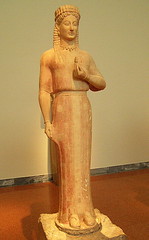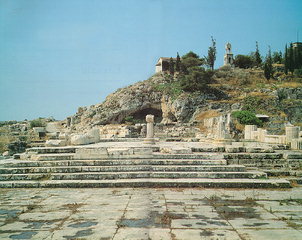In fact, it was a business trip, not a holiday, and I didn't even go to the bloody Parthenon. Want to make something of it? If you are interested in the artistic legacy of Greece, you are much better off at the National Archeological Museum. It's a bit away from the tourist trail, and you will have no crowds to compete with, except for the inevitable school groups. The exhibits are of a very high quality, and in some cases breathtaking.
There is, for example, a kore (female-figure sculpture from the pre-classical age) that I could hardly part from. The elegance of form, the innocent half-smile as if she were enjoying some private joke or delightful memory, the curtain-like braided hair were to wonder at. Even the designs on her clothing — flowers and geometrical accents — seemed perfectly in keeping with the mood evoked. (The colors of the paint were still faintly visible in places.) The artist or artists who created her more than 2,500 years ago had known what it was to love, I feel sure.
I awarded myself two days after I had concluded my work for sightseeing, which included, besides the archeological museum, several Byzantine and Greek Orthodox religious sites, including an 11th century monastery enfolded on the lower slope of Mount Hymettos. All were impressive, despite being (to contemporary eyes) remarkably small — remnants of a time before overpopulation encouraged gigantism in everything from airliners to shopping malls. In the Greek Orthodox churches, the lighting was dim and the old wood dark, which set out dramatically the intensely colored icons and gold and silver ornaments.
One such church was incongruously located in a city-center shopping precinct, surrounded by every allure that modern marketing can devise. These shops and boutiques are our religous sites, pilgrims in endless procession visiting them in search of baptism by glamour, salvation by ownership. A few people, almost all women — some, to my pleased surprise, as young as those queueing outside the Hard Rock Cafe — entered the church while I was there, made the sign of the cross, kissed the icons. The old rituals are not quite gone, not yet.
The rituals of Eleusis are gone. For two thousand years it was the scene of Mystery Rites that were, apparently, as close as the ancient Greeks and Romans came to mysticism in pre-Christian times, except perhaps in the Isis cult. Each year, many citizens of Athens, rich and poor, later augmented by visitors from the Roman Empire, celebrated the Eleusinian rites on nine days set aside for them. They walked from Athens to Eleusis on the Sacred Way.
Because the Mysteries were secret, no one knows precisely what happened during the ceremonies undergone by the initiates. There are many accounts, all speculative to a degree. It is generally agreed that the rites took their theme from the legend of Demeter and Persephone, although I suspect that was only their outermost aspect, which could be understood on some level by the masses. Those who were admitted into the innermost mysteries had a direct experience that enabled them to know death and rebirth.
The driver I hired to take me to the archeological site of Eleusis (located in Elefsina, a dreary modern Athenian suburb) said that in his dozen years of conveying tourists I was only the fourth who had asked to go there. The site was practically deserted, inhabited at the time by a ticket seller, a caretaker, and four or five dogs lounging where philosophers, emperors, and people of modest circumstances had sought knowledge of the Reality behind appearances. I saw two other visitors while I walked around.
Eleusis is a collection of ruins, but with the help of signs and a guidebook, you can get the general picture of what was where. It surprised me to learn how much the venue had been expanded and rebuilt by the Romans once they ruled Greece. Clearly it was an important place for many of them, including apparently the emperor Hadrian — known much more for his military and political interests than any religious beliefs.
I really hadn't expected much from Eleusis; it was just something I wanted to see for what it had been in ancient times. And I had no mystical experiences there (not that I'd expected any). Yet it did feel that I was in a place touched by eternity, although that may have been purely an intellectual response. I don't know if I would have felt the same if I hadn't known the locale's history. But it was oddly affecting to be walking on the ground from which had once risen the Telesterion, the large central building, where millennia ago the hierophants had led seekers to the most profound Knowledge.
It was cloudy and cool there that day. At times, though, the clouds shrank from the sun, and a bright, intense Mediterranean light revealed the world anew. Perhaps that was the only metaphor today's world could offer of what the Mysteries had once given to those who had walked the road to Eleusis.
"Blessed is he who has seen these things
before he goes beneath the earth;
for he understands the end of mortal life,
and the beginning (of a new life) given of God."
— Pindar
before he goes beneath the earth;
for he understands the end of mortal life,
and the beginning (of a new life) given of God."
— Pindar



No comments:
Post a Comment